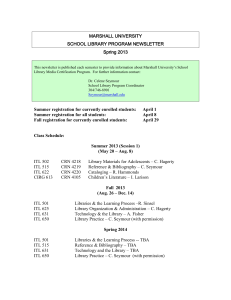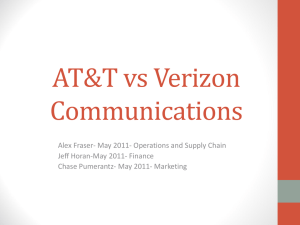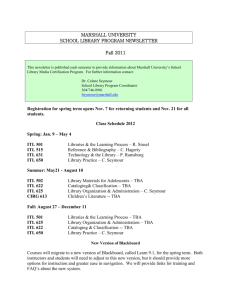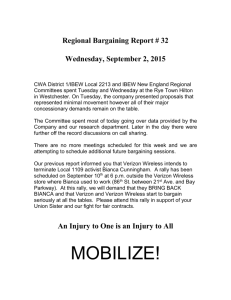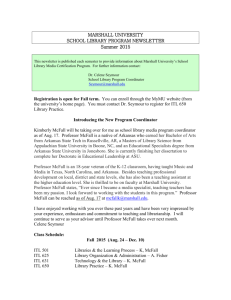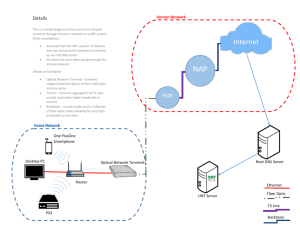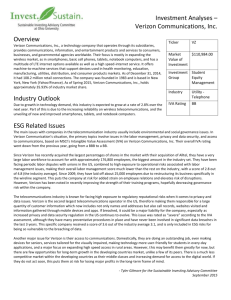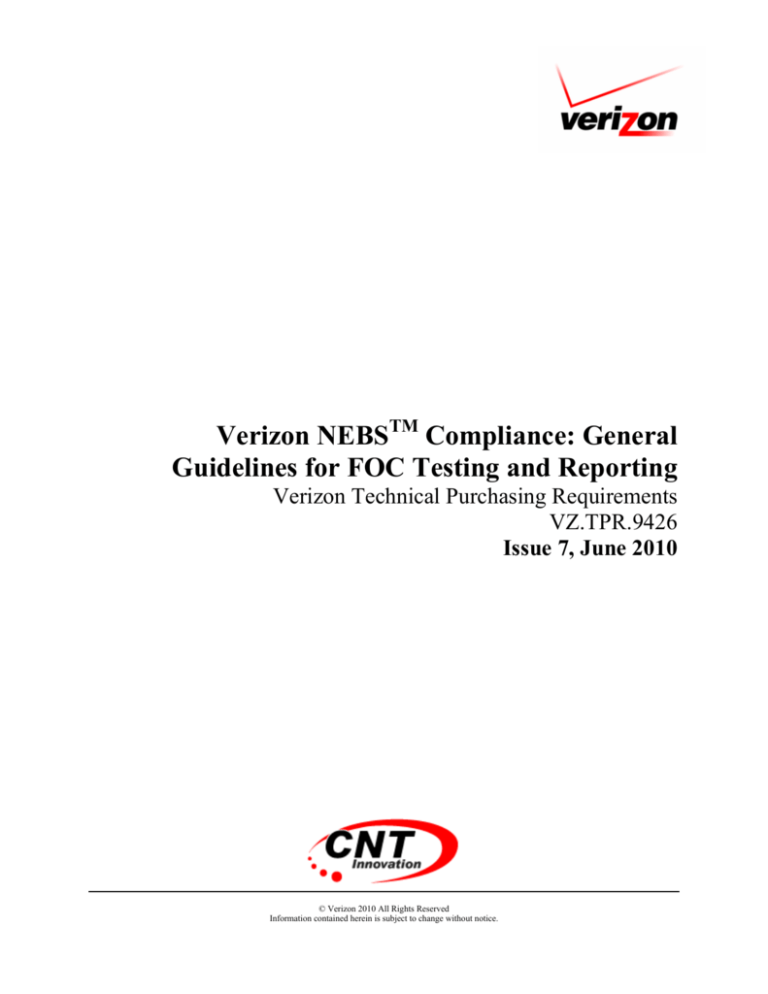
Verizon NEBSTM Compliance: General
Guidelines for FOC Testing and Reporting
Verizon Technical Purchasing Requirements
VZ.TPR.9426
Issue 7, June 2010
© Verizon 2010 All Rights Reserved
Information contained herein is subject to change without notice.
CHANGE CONTROL RECORD:
Version
Date
Action*
Reason for Revision
1
08/6/2007
New
New Document
2
10/04/2007
Add
Guidelines on subcontracted tests
Guidelines for using references in Test Plans
Guidelines for using Equipment List in Test Plans
3
10/15/2007
Change
Itemized the bullets in Section 5
4
06/10/2008
Change
Clarified item “l”
5
04/09/2010
Change
Added data reporting, Pass/Fail Determination and 5% channel monitoring
6
06/01/2010
Add
Added RCA requirements and clarified testing parameters
7
06/10/2010
Add
Added FQA section for reporting requirements in item “y”
* New, Add, Delete, Change, Reissue
Trademark Acknowledgement – NEBS is a trademark of Telcordia Technologies, Inc.
VZ.TPR.9426
Page - 2
© Verizon 2010 All Rights Reserved
Information contained herein is subject to change without notice.
PREPARED BY:
Name, Title, Organization
Vijay Jain M.Tech., M.A.Sc., PMP
FOC-ITL Program Manager
Corporate Network & Technology
320 St. Paul Place, Floor 14
Baltimore, MD 21202
Phone: 410-736-7947; Fax: 410-736-5144
E-mail: vijay.x.jain@verizon.com
Date
6/1/02010
APPROVED BY:
Name, Title, Organization
Ludwig C. Graff
Director, NEBS Compliance and Quality Assurance
Corporate Network & Technology
Systems Integration and Testing
320 St. Paul Place, Floor 14
Baltimore, MD 21202
Phone: 410-736-5904; Fax: 410-736-5144
E-mail: ludwig.c.graff@verizon.com
VZ.TPR.9426
Date
6/10/2010
Page - 3
© Verizon 2010 All Rights Reserved
Information contained herein is subject to change without notice.
Table of Contents
1.0
2.0
3.0
4.0
5.0
PURPOSE.................................................................................................................. 5
SCOPE ....................................................................................................................... 5
REFERENCES.......................................................................................................... 5
ACRONYMS ............................................................................................................. 5
GENERAL GUIDELINES....................................................................................... 5
VZ.TPR.9426
Page - 4
© Verizon 2010 All Rights Reserved
Information contained herein is subject to change without notice.
1.0
PURPOSE
The purpose of this Verizon Technical Purchasing Requirement document is to provide
general guidelines for FOC testing and reporting.
2.0
SCOPE
FOC Testing and Reporting
3.0
REFERENCES
PFOC Memo #40
PFOC Memo #26
4.0
ACRONYMS
FOC
ITL
SIT
TPR
5.0
Summary Notes
Notes and Information - Various GRs
Fiber Optic Components
Independent Testing Laboratory
System Integration & Testing
Technical Purchasing Requirement
GENERAL GUIDELINES
This TPR is issued to provide clear guidelines related to FOC component testing and
reporting.
If a test was audited and approved for one GR, and if the same test (same test set up,
procedure and configuration) is in another GR, then demonstration or auditing of this
test is not required. The test must be in the test plan.
b. Data Reporting - Record and report the actual test data, then account for connector
contribution by adding this to the criteria, GR specification and Verizon/Contracted
Specification. Include correction factors on data charts via limit indicators and
provide notation in data summaries indicating
a.
VZ.TPR.9426
Page - 5
© Verizon 2010 All Rights Reserved
Information contained herein is subject to change without notice.
c.
All products require all applicable tests required by the particular FOC Test Program.
If a subset test program is possible due to previous testing, then a meeting is required
with SIT, the supplier, and FOC ITL. The product must also be available for review.
Verizon SIT will participate one time, subsequent meetings or subsequent inquires
from a second, third, FOC ITL will not be possible. Therefore if a supplier wishes to
bid a particular test program, they should have all interested FOC ITLs present for the
review and agreement meeting.
d.
Full GR Test Programs require sample, configuration and test decisions by the FOC
ITL. It is expected that all FOC ITLs make these decisions and proceed with testing
following SIT requirements and specification referenced in the TPR’s - no advance
SIT approval is required.
e.
TPRs are to be used in conjunction with the GRs. If a conflict exists between the TPR
and the GR, then the TPR is the default and must be followed. All of these TPRs must
be part of the applicable test plans.
f.
For all GRs the pass/fail criteria will be the most stringent requirements of the
following: Generic Requirement (GR), Verizon Specification or the Supplier's
Specification. The specifications used must be defined in the test plan and report. The
supplier’s specification sheet is to be provided and inserted next to the product
description in the Test Plan and Report.
g.
For all GRs Test Plans/Reports it is the Supplier's Responsibility to ensure that the
worst-case test sample configuration (cable types and lengths, etc) is evaluated for
product qualification and that this configuration thoroughly exercises all design
variables and combinations that affect product performance.
h.
Photographic documentation of every test setup is required and must be included
within the test report providing adequate resolution to ensure all aspect of the set up
can be seen.
Reasoning: Accurate documentation of testing setup with photographs will ensure
testing can be easily repeated if required either for retesting of the product or future
testing of like products.
i.
Temperature charts and or data must be included within test reports for all
environmental sequences. This information may be in the form of a temperature chart
or data graphed data file representing the actual temperature data.
j.
All collected data (measured, temperature charts, etc.) must be included in excel with
the soft copy of all reports. It may be necessary at times for Verizon to go back and
look at the actual data and temperature charts during product evaluation to determine
compliance to a specific test requirement.
VZ.TPR.9426
Page - 6
© Verizon 2010 All Rights Reserved
Information contained herein is subject to change without notice.
k.
For all GRs and on all tracking documentation the fiber supplier and type of fiber
used must be indicated for each product. Product tested with special bend optimized
or insensitive type fiber is not necessarily approved for use with standard type fiber,
i.e.: SMF28-E.
l.
VWDM modules utilizing electrical support circuitry will never be used in Outside
Plant environments, and will only be used in Central Office environments. Testing to
GR-63 Central Office temperatures (-5 C to +50 C) is accepted for these modules.
This is due to the reliability of electrical components. VWDM devices and modules
that are not utilizing electrical support circuitry must be tested as per GR-1209/1221
and associated TPRs.
m. Network Creation has eliminated the need to use 1625 nm for VWDM devices this
change allowed for improvement in the devices provided (Performance improved
significantly at the other three wavelengths). Since the device will not be used or
designed for performance at the 1625 nm wavelength, testing is not required. This
applies only to VWDM devices.
n.
The usage of bend radius limiters during any testing is expressly prohibited unless
specifically referenced within the TPR.
Reasoning: The intent of a test is to simulate actual stress, which may be exerted on
product either in transportation, handling, installation or deployment. Since these
products will not be deployed utilizing bend radius limiters, any usage during testing
would skew and invalidate the results of the testing.
o.
It is the Labs (Supplier and or ITL as applicable) responsibility to safely perform
testing at temperature extremes, by using appropriate attire, restrictions and
procedures.
p.
Reference to Work Instructions or SOPs in a Generic Test Plan:
Follow either A or B:
A - Point to a Work Instruction from the test plan. The local procedures
must have issue or rev number and associated date in the body of the test
plan and in the summary table of reference docs in the front of the test
plan.
B - Include the entire test method and only point to ASTM or FOTP like
documents as references.
q.
Labs do not need to list all equipment - only enough to perform each test setup.
r.
Subcontracting Tests for Witnessed Lab:
VZ.TPR.9426
Page - 7
© Verizon 2010 All Rights Reserved
Information contained herein is subject to change without notice.
Case-1: Witnessed Lab CAN perform the test but the Primary ITL CANNOT do
the test: Witnessed Lab tests must be witnessed by an ITL that is approved to
perform the specific test in their own lab. If the Primary FOC ITL cannot perform a
test in their own lab then the particular test will need to be subcontracted to a
Secondary ITL who is approved to perform the test. The Primary ITL will need to
have a contractual relationship with another ITL to cover the tests that they do not
perform. Witnessed Lab can, therefore, still use one lab who will act as the general
contractor. The witness from the second ITL will need to be at Witnessed Lab during
testing. The second ITL will submit a separate test report that is added to the
addendum of the master test report - results are culled and inserted into the master
report. The credentials of the Secondary ITL witness will need to be submitted to
Verizon for approval.
Case-2: Both Witnessed AND the Primary ITL CANNOT do the test: Tests that
Witnessed Lab will outsource to the Primary ITL will need to be performed by the
ITL in their lab facility. If the FOC - ITL cannot perform a test in their own facility
they must have a contractual relationship with a second FOC - ITL to cover tests that
they themselves outsource. The second ITL will perform the test and submit a test
report to the Primary ITL. Test results will be included in the master test report and
also as a separate report in the addendum. Witnessed Lab can, therefore, still use one
lab that will act as the general contractor and incorporate the Secondary ITL's report
into the master report. Witnessed Lab can also go direct to a second ITL.
Case-3: FOC Tests with no Optical Monitoring: Tests that are part of the FOC
Program but do not require optical monitoring may also be performed by an approved
NEBS ITL, for example: Wind Driven Rain (WDR). A separate report will be
prepared and submitted to the Primary ITL for inclusion in the addendum of the
master test report. Results will be inserted into the master report. Witnessed Lab can
elect to contract directly with an approved ITL for such tests. If Witnessed Lab has
test facilities for a test such as WDR, that are approved by Verizon, then an ITL FOC
or NEBS witness can be present during testing. Credentials of the witness will need to
be submitted to Verizon for approval.
s. All labs must use 5% of the optical channels as the reference channels in an optical switching
system test setup. These channels shall be uniformly selected over the switching system. For
example in a 100 channels optical switching system channels 1, 21, 41, 61 and 81 can be
selected as the reference channels.
t. Data Reporting Guidelines:
o Product is not under contract by VZ or is not being considered for deployment
(field trial) or under evaluation in a RFI/RFP/RRP
Complete the FOC testing and provide complete test report
o Product is not under contract by VZ but is being considered for deployment (field
trial) or under evaluation in a RFI/RFP/RRP
Provide status of testing including all failures till that date from the ITL to
FOC team
VZ.TPR.9426
Page - 8
© Verizon 2010 All Rights Reserved
Information contained herein is subject to change without notice.
Provide any internal testing data including all failures till that date to FOC
team
o Product is under contract and is assigned Low Risk for deployment after Red Flag
Testing
This scenario is very well documented in GR-1221 R3-16, O3-17;
provisional use of devices
Verizon requires that any failure observed during the testing must be
reported by ITL to FOC team within 24 hours
The information must include:
• Product name
• ITL and/or witnessed lab name and location
• Test Failed
• Number of samples failed
• Criteria Failed (GR/TPR/VZ/Supplier)
• ITL Project Number
A detailed RCA must follow the failure within 5 working days of the
failure.
FAQ:
• Q: Should we wait for all the samples to complete that particular
test before reporting failures?
• A: No, report as failure happens. It can take several weeks for the
test to complete.
• Q: Environmental test failures cannot be reported until testing is
complete and data is analyzed. How the data should be reported?
• A:
• Environmental Tests: Report failures when intermediate
measurements are made
• Mechanical Tests: Report failures as they happen
It is supplier’s responsibility to conduct RCA not ITL’s
ITL = Independent Test Lab
VZ’s CFT makes the determination on whether to accept a failure or not
Risk analysis is performed by VZ and not by supplier or ITL
It is ITL’s responsibility to ensure that data is reported to Verizon
correctly and in timely manner
u. Pass/Fail Determination:
o Setup and/or test equipment accuracy cannot be used to pass failing samples
o Example:
IL max = 0.45dB
Equipment Accuracy = ±0.05dB
Pass Criteria = 0.4dB
Result Reported = Pass; WHY?
It can be = 0.5dB as well (worst case)
VZ.TPR.9426
Page - 9
© Verizon 2010 All Rights Reserved
Information contained herein is subject to change without notice.
o Number of samples are defined in TPR and are taken from international standards
o Number of failures allowed on samples during testing is based on well established
methodologies and cannot be changed
o Example: Long term Environmental Reliability test on 12 fiber Multi fiber
connectors
ITL/Supplier reported 3 out of 264 (12 fibers x 22 samples) fibers failed
IL criteria
Supplier states that no RCA and CA is needed as failures are so few
Investigation reveals these 3 fibers are on three different connectors
Reliability test has a requirement of “0” failure on 22 samples per LTPD
of 10%
So instead of 3/264 failures these are 3/22 failures
This can equate to a very high failure rate
o If a single fiber goes non conforming in a 12 fiber connector; VZ field technician
will have to bring down service of 11 customers to repair
o Example: During a 72 fiber loose tube cable testing, 3 cable samples are used.
ITL/Supplier reported 3 out of 216 (72 fibers x 3 samples) fibers failed IL
criteria
Supplier states that no RCA and CA is needed as failures are so few
Investigation reveals these 3 fibers are on three different samples
This equates to 3/3 = 100% failure
In the case of cables where rule of 90% and 10% is allowed; this rule is
applicable for each sample and not for combination of all samples together
v. Audit findings from ITL and supplier audits shall be closed within 60 days or as listed in the
audit report.
w. Requirements vs Objectives:
• All Requirements listed in TPRs and GRs require compliance.
• All Objectives listed in TPRs shall be tested and shall be reported. The test results
from Objectives are for information purposes only.
x.
Root Cause Analysis (RCA):
• Suppliers no longer need to provide an RCA to Verizon on failures while testing is in
progress.
• For any failure, suppliers shall conduct an RCA, implement the Corrective Action,
test the Corrective Action (may require a separate test program or restarting the
program) and include this information in the final report.
•
For products under Verizon contract or under RFP review, any change in testing
schedule shall be communicated to the Single Point of Contact (SPOC) on the FOC
team.
•
It is the responsibility of the ITLs to ensure that final test report includes all of the
information listed in second bullet of item “x” above.
VZ.TPR.9426
Page - 10
© Verizon 2010 All Rights Reserved
Information contained herein is subject to change without notice.
y.
Following are answers to some Frequently Asked Questions:
• Question: Unless there is a RFP or other specific reason for identifying a different
SIT contact, Supplier will send or direct the ITL to send test reports and all other
FOC related information to SPOC.
Answer: This is Correct
• Question: Any request for supplier lab audits should be sent to Chuck Graff by the
ITL.
Answer: This is correct.
• Question: Test Failures in FOC Programs when product has not been shipped to
Verizon: Neither supplier nor ITL are required to report failures to Verizon. The
supplier will conduct internal RCA, determine corrective action, and retest as
required and determined by the ITL – the results and corrective action will be
incorporated into the final test report. The ITL is authorized by Verizon to determine
the retest requirements for a failure correction – no approval from Verizon is
required.
Answer: Verizon reserves the right to review the ITL test requirements and require
rests if necessary.
• Question: In the case where the test program is for a new product that is also under a
RFP or under a contract (BUT not yet shipped) then any change in test schedule must
be communicated to the Verizon-SIT contact.
Answer: This is correct
• Question: In the event that a test report is provided to Verizon for a product with
status as defined in previous question with test failures that were not corrected during
the test program, then Verizon will not accept the product.
Answer: This is correct
• Question: Can products be shipped to Verizon before FOC testing is complete?
• Answer: Products shall not be shipped to Verizon until successful completion of FOC
has been achieved.
VZ.TPR.9426
Page - 11
© Verizon 2010 All Rights Reserved
Information contained herein is subject to change without notice.

